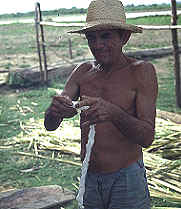

Here is José Maria again. He is rolling up some cotton, taken from a plant grown on his land. The cotton will be used to caulk his canoe. Once the cotton has been inserted in the crack or hole some resin like substance is smeared over the area in order to act as a sealant.
José Maria was born in 1935 on Parú. His mother was living with her parents, since his father did not accept his paternity - he was married to someone else with his own family. He grew up with his two future wives, two sisters, who lived on the same parcel of land. The sisters were technically his second cousins, related through his father, but because this relationship was not recognised, it had no meaning and consequence. The mother of the two sisters was the adopted child of José Maria's grandparents, which is how they ended up on the same parcel of land. At the age of eight, José Maria left with his mother to a cattle owner's house further up the coast of Parú, belonging to Brei Jordão, an Italian immigrant from the 1920s. His mother became a kind of house maid for Brei Jordão, and José Maria helped round up cattle, fish for food and with numerous other tasks.
The 1930s was an important time for Brazil. Getulio Vargas, a Brazilian equivalent of Raul Peron, had become president at the beginning of the decade and begun an attempt to modernise Brazil, by nationalising large industries and services. He had mass support for all his reforms, and indeed talking to people on Parú and elsewhere, he is remembered fondly as the one Brazilian president who tried to do anything to help the poor (see also Verena Stolcke 1988 for memories of Vargas amongst São Paulo coffee planters). Despite this modernising vision for Brazil, Amazonia remained pretty much ignored in its thick veil of humid mists. The rubber boom, which had brought extravagance and a vast increase in economic activity to the region, had ended in 1911 and gave way to a period of little external or State intervention. The period following the Rubber Boom was crucial to the vitalisation of local communities and ways of living. It ended at the end of the 1960s when the new military dictatorship invented their 'national integration plan', which for the Amazon meant the building of roads and the resettling of migrants in new towns. However, the effect of this plan was little felt in the area where José Maria lived. His nearest towns were only accessible by boat (or airplane), and most migrants had no desire to move to riverine areas (nor were they encouraged to).
José Maria was born, then, exactly in the middle of the strengthening of the local economy and growth of rural communities. He and many other people used to tell me how when they were children, there was lots of land available on Parú. 'It used to be exchanged for fish, it was so common', Alcina his wife told me. Nowadays at the other end of the 20th century, there is no land available. Indeed, parcels of land are getting smaller and smaller, as they are passed down through inheritance. The demand for the space has also entailed a proliferation of cousin marriages, thereby keeping valuable resources within the large family, and leading to dense networks of kinspeople. In this respect, it is important to mention that floodplain dwellers do not own the land or water they use, but generally maintain usufruct rights to these resources through regular access. By remaining on the land, they secure their future and the resources needed to guarantee it.